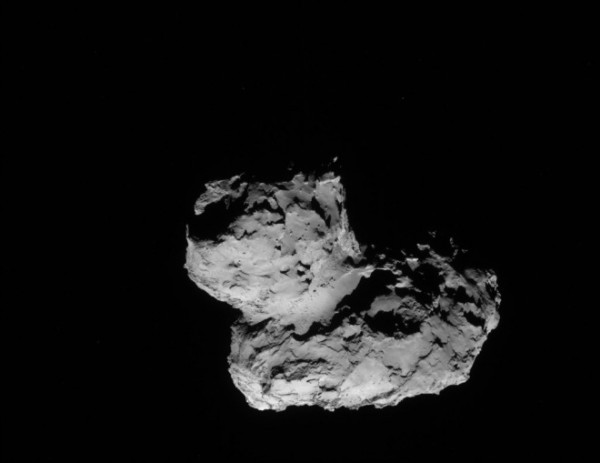Here's Why Comet 67P Looks Like a Duck
| Marco Foronda | | Dec 26, 2014 06:26 AM EST |
(Photo : ESA/Rosetta/NAVCAM) The two lobes of comet 67P/Churyumov-Gerasimenko somewhat resemble the head and body of a duck.
Scientists continue to evaluate new images and data from the Rosetta mission to comet 67P/Churyumov-Gerasimenko and they are slowly finding clues as to why the comet looks like a duck.
Comet 67P consists of two lobes, which reminds one of the head and body of a duck. Philippe Lamy, a planetary scientist at the Astrophysics Laboratory of Marseilles in France, believes erosion or collision or both could have formed comet 67P.
Like Us on Facebook
Simone Marchi, a planetary scientist at the Southwest Research Institute in Boulder, Colorado, said analysis reveals fractures and layering features seem to support the latter scenario.
The comet's double-lobed shape isn't bizarre because comet Borrelly (Deep Space 1 in 2001) and comet Hartley 2 (Deep Impact/EPOXI spacecraft in 2010) also consist of two lobes. Experts aren't quite sure whether these two comets were formed from erosion or a collision. Whichever the case, the process seems to be a general one that happens to many comets.
Marchi and her colleagues used new images taken with Rosetta's OSIRIS camera to discover terrace-like layers on the comet's body.
The layering aligns flawlessly with parallel lines seen on the opposite side of the body. It means these layers extend through the body as part of its internal structure.
The "head" is composed of layers, too, but they don't align with those in the body and that means the two lobes were once two separate pieces.
The neck of the comet also demonstrates signs of a collision between the head and the body. The region is covered in big fractures, which would have been created by shockwaves that blasted through the comet during a crash.
Some of the fractures are also misaligned, suggesting they belonged to what were separate, smaller chunks floating around when the head merged with the body.
The general appearance of the head and neck are also somewhat different, according to the analysis. For example, there are more smooth patches that cover the body than the head.
Marchi adds the Rosetta mission could give better data and higher resolution pictures that will point scientists closer to the true answer.
Tagscomet 67P, Churyumov-Gerasimenko, NASA, Rosetta mission, comet, space exploration
©2015 Chinatopix All rights reserved. Do not reproduce without permission
EDITOR'S PICKS
-

Did the Trump administration just announce plans for a trade war with ‘hostile’ China and Russia?
-

US Senate passes Taiwan travel bill slammed by China
-

As Yan Sihong’s family grieves, here are other Chinese students who went missing abroad. Some have never been found
-

Beijing blasts Western critics who ‘smear China’ with the term sharp power
-

China Envoy Seeks to Defuse Tensions With U.S. as a Trade War Brews
-

Singapore's Deputy PM Provides Bitcoin Vote of Confidence Amid China's Blanket Bans
-

China warns investors over risks in overseas virtual currency trading
-

Chinese government most trustworthy: survey
-

Kashima Antlers On Course For Back-To-Back Titles
MOST POPULAR
LATEST NEWS
Zhou Yongkang: China's Former Security Chief Sentenced to Life in Prison

China's former Chief of the Ministry of Public Security, Zhou Yongkang, has been given a life sentence after he was found guilty of abusing his office, bribery and deliberately ... Full Article
TRENDING STORY

China Pork Prices Expected to Stabilize As The Supplies Recover

Elephone P9000 Smartphone is now on Sale on Amazon India

There's a Big Chance Cliffhangers Won't Still Be Resolved When Grey's Anatomy Season 13 Returns

Supreme Court Ruled on Samsung vs Apple Dispute for Patent Infringement

Microsoft Surface Pro 5 Rumors and Release Date: What is the Latest?










